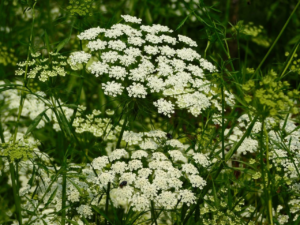![]()
 This entry will be the first in a new series bringing you information on the various plants and herbs that can be found growing in the Sambhavna clinic’s beautiful community gardens. The gardens are a place of community and shared healing, acting as both a place of recuperation and rehabilitation for those suffering from mental health issues, and a source of plants and herbs used in the treatment of physical ailments. In particular, many of the plants and herbs found growing in the garden are used at the centre in traditional Ayurvedic medicinal treatments for survivors of gas and contaminated water exposure. Sambhavna’s utilisation of such traditional methods alongside modern medicinal practices, with each informing the other, is an innovation, producing remarkable results.
This entry will be the first in a new series bringing you information on the various plants and herbs that can be found growing in the Sambhavna clinic’s beautiful community gardens. The gardens are a place of community and shared healing, acting as both a place of recuperation and rehabilitation for those suffering from mental health issues, and a source of plants and herbs used in the treatment of physical ailments. In particular, many of the plants and herbs found growing in the garden are used at the centre in traditional Ayurvedic medicinal treatments for survivors of gas and contaminated water exposure. Sambhavna’s utilisation of such traditional methods alongside modern medicinal practices, with each informing the other, is an innovation, producing remarkable results.
Ajamoda, botanical name apium graveolens, grows wild around the globe and its seeds have been used in herbal medicine, including Ayurveda, since ancient times. In addition to the seeds its beautiful flowers, as seen in the picture, can be used in the treatment of numerous medical conditions. At Sambhavna, the seeds of the ajamoda are used in the preparation of both Ajamodadi Churna and Hingwashtaka Churna, classical Ayurvedic medicinal formulations, by the medicine making department.
As in other ancient cultures including China, Egypt, Greece, and ancient Rome, traditional Ayurvedic medicine is based on a principle of balance between bodily humours. There are three bodily humours (doshas) in Ayurveda: Vatta, Pitta, and Kapha. The various substances in the body were traditionally divided into the five classical Indian elements of earth, water, fire, air, and ether, with the three humours governing combinations of the five. Although this terminology is still used in Ayurveda, we can now also explain which conditions and illnesses these formulas are beneficial for in modern medicinal terms.
In the case of formulations containing ajamoda seeds, Ajamodadi Churna has pain relieving, anti-inflammatory, and diuretic properties. In traditional Ayurveda, it is said to be effective for treatment of Vata (air and earth) and Kapha (water and earth) disorders, as well as Deepana (digestive) disorders. At the clinic it is used for the treatment of neuromuscular disorders like joint pain, backache, sciatica, and rheumatoid arthritis. This makes it particularly essential to the work taking place at Sambhavna, as the findings of the International Medical Commission on Bhopal suggest that neuromuscular disorders are the second most common condition among survivors of gas exposure after respiratory disorders. Ajamodadi Churna can also be used in the treatment of indigestion or a weakened digestive system, constipation, urinary problems, and cardiovascular problems.
In Ayurveda Hingwashtaka Churna is used specifically for Vata (air and earth) disorders. It is carminative and used to relieve symptoms of chronic conditions affecting the joints or digestive system, such as joint pain and swelling, indigestion, bloating, and constipation.
As you may already have guessed from the botanical name of the plant and the images, ajamoda is known in English as the common celery plant.
Our thanks go to Sambhavna staff Vishwamohan, pharmacist, and Dr. Rupa, expert in Ayurvedic medicine, for sharing this information with us, and to our trustee Sathyu for the beautiful photograph.


